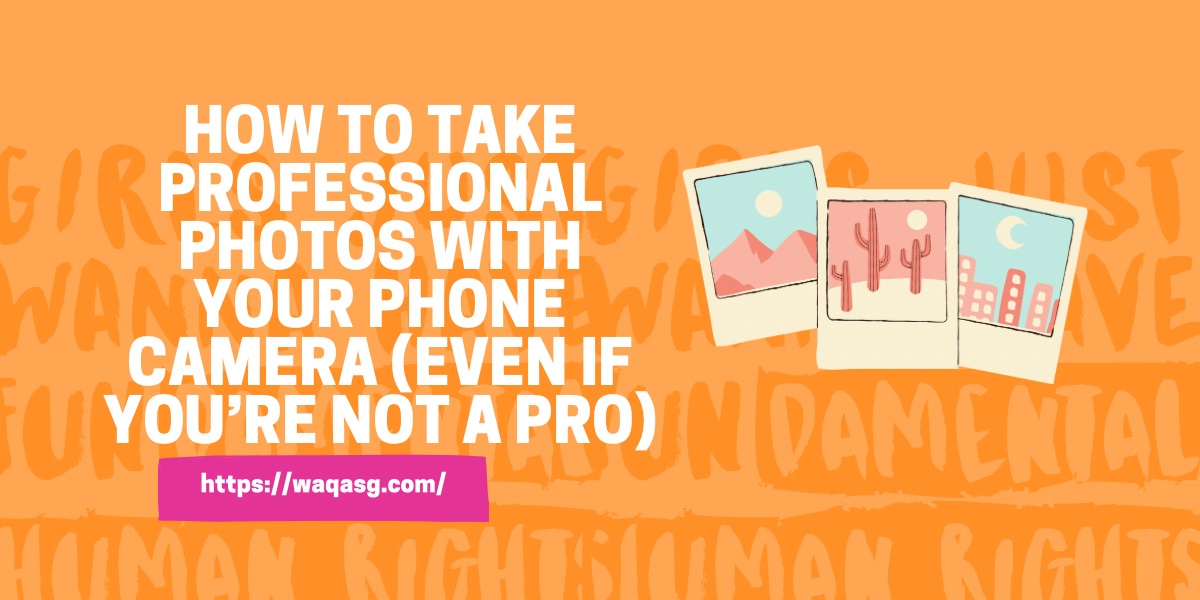
Let’s be honest—phone cameras have come a long way. These days, you don’t need a fancy DSLR or editing software to take jaw-dropping photos. You’ve already got a powerful camera right in your pocket—you just need to know how to use it.
Whether you’re capturing sunsets, food, pets, or just trying to level up your Instagram game, learning a few tricks can make a massive difference. And no, you don’t need photography school or expensive gear. With the right tips and a little practice, you can start taking photos that actually look professional—using just your phone.
In this guide, I’ll break down simple, practical steps anyone can follow. No confusing terms, no fluff—just real advice you can use today.
Let’s get into it.
1. Understand Your Phone Camera’s Capabilities
Before you start snapping away, take a minute to actually get to know your camera. Most people never explore beyond the basic “photo” mode—but your phone probably has way more to offer.
Here’s what you should check out:
- Lens types – Does your phone have a wide-angle, ultra-wide, or telephoto lens? Each one serves a different purpose. Use ultra-wide for landscapes, and telephoto for portraits or zoom shots.
- Megapixels aren’t everything – High megapixels are great, but what matters more is how your camera handles light, focus, and image processing.
- Pro or Manual mode – Some phones offer a manual setting where you can control ISO, shutter speed, white balance, and focus—just like a DSLR. It’s perfect for learning photography basics.
- HDR mode – This helps balance bright and dark areas in tricky lighting. Try it out in scenes with lots of contrast (like a bright sky and a dark foreground).
- Portrait mode – Great for adding that creamy background blur (a.k.a. bokeh). Ideal for people, pets, or products.
Pro tip: Spend 5–10 minutes exploring your camera app settings. Try switching between modes, tapping on different subjects to focus, and adjusting exposure sliders. The more you know your camera, the better your results.
2. Master Lighting: Your Photo’s Best Friend
If there’s one thing that can instantly make or break a photo, it’s lighting. Even the best phone camera will struggle in poor lighting—but give it good light, and the results can be stunning.
Here’s how to make lighting work for you:
Natural Light Is Your Best Friend
Daylight—especially soft, indirect light—is the easiest way to get clear, flattering shots.
- Shoot near windows when indoors
- Go for golden hour (shortly after sunrise or before sunset) for that warm, glowy look
- Avoid harsh midday sun that causes strong shadows unless you’re going for a dramatic effect
Don’t Be Afraid of Shade
Taking photos in the shade can actually give you softer, more even lighting—especially for portraits or close-ups.
Use Artificial Light Wisely
If you’re indoors and the lighting sucks, don’t rely on your phone’s flash. Instead:
- Use a desk lamp with a white bulb
- Bounce light off a wall for a softer effect
- Consider a small ring light or portable LED if you shoot a lot
Backlighting Tips
Shooting toward the light source? Tap the subject on your screen to expose them properly, or switch to HDR mode to balance it out.
Pro tip: Always take a second to look at how the light is hitting your subject. Sometimes just turning slightly or moving your phone a bit can completely change the photo.
3. Composition Tips: Make Every Shot Look Intentional
You don’t need a photography degree to make your photos look thoughtful and professional—just a few easy composition tricks can totally change how your images feel.
Rule of Thirds
This is a classic for a reason. Imagine your screen is divided into a 3×3 grid (most phone cameras let you turn this on in settings).
Place your subject where the lines cross—not dead center. It gives your photo a more natural, balanced feel.
Use Leading Lines
Look for lines in your scene—like roads, walls, fences, or shadows—that naturally guide the viewer’s eye toward your subject. This adds depth and storytelling to your image.
Don’t Be Afraid to Move Around
Most people take photos from chest height—but crouch down, shoot from above, or get closer. Changing your angle instantly makes your photos stand out.
Leave Some Breathing Room
Give your subject a bit of space. Whether it’s a person or an object, tight framing can feel cramped. A little background context goes a long way.
Use Natural Frames
Shooting through something—like a doorway, window, or leaves—adds layers and makes your photo more dynamic. It’s a subtle but powerful trick.
Pro tip: Before you tap the shutter, pause and ask yourself: “Is this photo telling a story, or just showing something?” Tiny changes in framing can turn a random pic into something eye-catching.
4. Use Focus & Exposure Tools Like a Pro
Your phone camera does a pretty good job on auto mode, but if you want that next-level control, learning to manually adjust focus and exposure is a game-changer.
Tap to Focus
Don’t just aim and shoot—tap on your subject to make sure the camera is focusing where you want. This is especially important in portrait or close-up shots.
Adjust Exposure Manually
After you tap to focus, you’ll usually see a little sun icon or slider next to the focus box. Slide it up to brighten or down to darken the image. This is super useful when:
- Your subject is backlit
- The photo looks too washed out or too dark
- You want a moody, underexposed look
Lock Focus and Exposure (AE/AF Lock)
On most phones, if you tap and hold your subject, it will lock the focus and exposure. That means the lighting and sharpness won’t shift even if you move slightly—perfect for tricky shots or when you want consistency.
Pro tip: Try slightly underexposing bright outdoor shots—this preserves detail and gives you more to work with when editing.
5. Clean Your Lens (Seriously, Just Do It)
This might sound too simple to matter, but hear me out: a dirty lens ruins more phone photos than anything else. Pocket lint, smudges, fingerprints—they can all make your shots look foggy, blurry, or just plain dull.
Before you shoot, give your lens a quick wipe using:
- A microfiber cloth (best option)
- Your shirt (not ideal, but better than nothing)
- A camera-safe cleaning wipe (if you have one handy)
- And if you’re using a phone case with a raised edge, make sure it’s not accidentally blocking part of the lens, especially when using ultra-wide angles.
Pro tip: Make this a habit before taking any serious photos. It takes 2 seconds and could literally be the difference between a sharp, vibrant shot and a blurry disappointment.
6. Edit Like a Pro (Without Overdoing It)
Great photos often aren’t just about how you shoot—they’re also about how you finish them. The good news? You don’t need Photoshop or a desktop computer. A few simple tweaks in the right apps can turn a good photo into a great one.
Best Mobile Editing Apps
- Snapseed (Free) – Powerful, intuitive, and beginner-friendly
- Lightroom Mobile (Free + Premium features) – For serious control over lighting and color
- VSCO – Stylish filters and subtle editing tools
- Google Photos – Surprisingly good built-in editing for quick adjustments
Editing Tips: Less Is More
- Crop & straighten – Fix framing, level horizons, remove distractions
- Adjust brightness & contrast – Bring out the details without blowing out highlights
- Play with saturation (carefully) – Boost colors without making it look cartoonish
- Sharpen just a little – Helps bring back details, especially in portraits or landscape shots
- Use filters lightly – One-click filters are tempting, but too much can make photos look fake or over-processed
Bonus: Try Presets
Apps like Lightroom let you save or download presets—custom editing styles that give your shots a consistent aesthetic. Great if you want that “Instagram feed” vibe or a branded look.
Pro tip: Always keep the original version saved. Sometimes a second look the next day helps you edit with fresh eyes.
7. Bonus Tips: Little Tricks That Make a Big Difference
These aren’t rules—just things that’ll take your phone photography from decent to “whoa, you took that on a phone?”
Use Portrait Mode… But Not Just for People
Try it on pets, food, or even random objects. It gives you that nice depth-of-field (background blur) that adds a pro feel to your shots.
Try Night Mode (But Stay Steady)
Modern phones do surprisingly well in low light—but only if you keep still. Lean against something, or rest your phone on a surface if your hands are shaky. Night mode usually takes a few seconds, so patience pays off.
Turn On Gridlines
It helps with composition, symmetry, and straightening shots. Especially useful for architecture, street shots, or flat lays.
Burst Mode for Action Shots
Photographing movement—kids, pets, sports? Use burst mode to snap a quick sequence, then pick the best one later.
Get Close, Don’t Zoom
Digital zoom kills quality. Walk closer instead of pinching in, especially if you want detail and sharpness.
8. Final Thoughts: Practice Beats Gear
The truth is, professional-looking phone photography isn’t really about the phone. It’s about how you use it. The more you practice—trying out angles, lighting, edits—the better your shots will get.
So take your time, experiment with the tips above, and trust your eye. You don’t need a $2000 camera to take photos that make people stop scrolling. You just need a little know-how, some intention behind each shot, and a phone that you probably already own.
Now get out there—and start creating!
Conclusion
So there you have it—you don’t need a fancy camera to take stunning photos, just a phone and a little bit of know-how. With the right lighting, solid composition, and a few pro-level tricks, your phone shots can start turning heads in no time.
Try these tips out, play around with your camera settings, and most importantly—have fun with it. Photography is all about creativity, not perfection. The more you shoot, the better you’ll get.
And hey—if you take a photo you’re proud of, tag me or drop it in the comments. I’d love to see what you capture!





No comment yet, add your voice below!